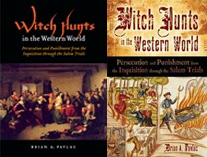What are the methods of torture?
Torture to gather INFORMATION, in medieval terms: Putting to the Question
Torture usually follows RULES (begun to be established by the medieval inquisition of the Catholic Church). These rules were designed to help protect the accused. Sometimes rules exempted certain people from torture, such as minors, the sick, the elderly, pregnant women, scholars with degrees, and nobles. Also, if one survived torture, the court considered one innocent.
-
The person is presumed guilty.
-
The torture is authorized by legal procedures (often with a standard set of questions).
-
The torture is observed and recorded.
-
The torture is of limited duration (limited by Pope Clement V to "one session"--which was gotten around by "pausing" a session and "continuing" it on another day).
-
The torture is carried out with increasing intensity (gradatim).
-
The torture leaves no permanent physical damage to the victim (perhaps with explicit forbidding of shedding blood).
-
The torture does not kill the victim.
-
Victim must repeat confession outside of torture, as admissable evidence in court (failure to do so, however, might result in repeated torture).
During the witch hunts, torture expanded the number of victims as "confessions" implicated more people as witches. These were of course "false confessions," lies to stop the pain, or manifestations of mental instability. Where torture was not used, or was carefully regulated, witch hunts were non-existent, rare, or limited.
Below are examples of methods and tools of torture used in the European Witch Hunts.
Increasing Intensity
| 1st degree--ask for confession | 2nd degree--threaten torture | 3rd degree--prepare for torture |
| 1st degree--ask for confession | 2nd degree--threaten torture | 3rd degree--prepare for torture | 4th degree--screws | 5th degree--rack |
Mental tortures:
| Threatening of victim, family, or others | Degrading | Isolating |
Physical tortures:
| Discomforting: | Pulling: | Expanding: |
Striking: |
Judas cradle; fork; dunking; heat or cold; |
 strappado or pendulum (with squassation); strappado or pendulum (with squassation);
rack; ladder |
force feeding |
Newgate Prison beating; cane/rod; whip |
| Mutilating: | Crushing: | Burning: |
[modern: Electricity |
| flaying; whipping; gouging; plucking; pulling off nails; pulling teeth; sticking pins; ripping flesh; cutting |  screws; screws;
twisting ropes; garrote; pressing; wedges |
fire; hot irons; scalding water; hot oil; fat; tear gas; pepper; acid; "hold feet to the fire" |
cattle prods; stun guns; tasers; batteries; outlets |
Torture as PUNISHMENT
For most crimes before 1800, torture during the investigation and trial could be supplemented during the punishment. The attitude of the Enlightenment, such as in the U.S. Constitution, Amendment VIII nor cruel and unusual punishments inflicted, helped to end the use of torture in punishment. The tendency of Western nations has at least officially been to moderate the cruelty used in punishment. Most crimes are punished today by fines, imposing community service, or confinement (house arrest or imprisonment). An allegedly common goal of modern imprisonment is rehabilitation: reforming criminals into good citizens. The conditions of many modern prisons, however, which include beatings and rapes by fellow prisoners, might be considered a form of torture.
Common legal punishments during the age of the Witch Hunts:
| Degrading: | Striking: | Mutilating: | Isolating | Executing: |
| pillory/stocks; hard labor; fiddles; weights; signs | flogging; beating; caning | flogging; branding; blinding, chopping off of ear, nose, tongue, fingers, toes, hands, feet, | exile; jail; solitary confinement: for evaluations that such is torture see Atul Gawande in The New Yorker; Dr. Jeffrey Metzer in a journal of Psychiatry Law; |
hanging; burying alive; immuring; starving; drowning; burning; boiling; impaling; sawing; flaying; ripping with tongs; disemboweling; drawing & quartering; beheading; breaking on the wheel |
Some Useful Links:
Torture list of Cologne 1757: A list of the prices charged to victims of torture. Although part of a page describing autos-da-fé at an atheist website attacking atrocities by Christians, the source reflects genuine, and ironic, cruelty.
Tyburn Tree: Excellent site includes links to primary source pictures, poems, speeches, literary references, etc. about executions in Early Modern England. Mostly about normal criminal executions, but relevant to witch punishments. [Created by Zachary Lesser of Columbia, then located at the University of North Carolina, expanded, maintained by Charlie Mitchell, who has restored it in blog form].
The Proceedings of the Old Bailey, London 1674 to 1834: Searchable database of over 100,000 crimes, including a few "witches."
Newgate Calendar: 18th-19th-Century English book listing criminals and punishments. Includes some witches among them (e.g. Mary Bateman 1809, Thomas Colley, 1751).
Medieval Crime Museum: Brief web material covering an excellent criminal history museum, Kriminalmuseum, in Rothenburg-ob-der-Tauber, Germany.
Historical Torture Museum: From a traveling exhibition based on exhibits from the Medieval Criminal Museum in San Gimignano, Italy. Includes some pictures and reflections.
Kenneth Pennington: Dance to the Music of Torture lecture, Hitchiker's Guide to Torture, Jurists' Definitions, Past and Present.
![]()
| What is torture? | Why is torture done? | What are the methods of torture? |
| Primary Source: Letters from the Witch Trial of Rebecca Lemp: a family deals with accusations. |
Torture post 9/11 | Suffer your own persecution! Try a witch hunt simulation: make choices to survive or not. |
 Buy the Book!
Buy the Book!


